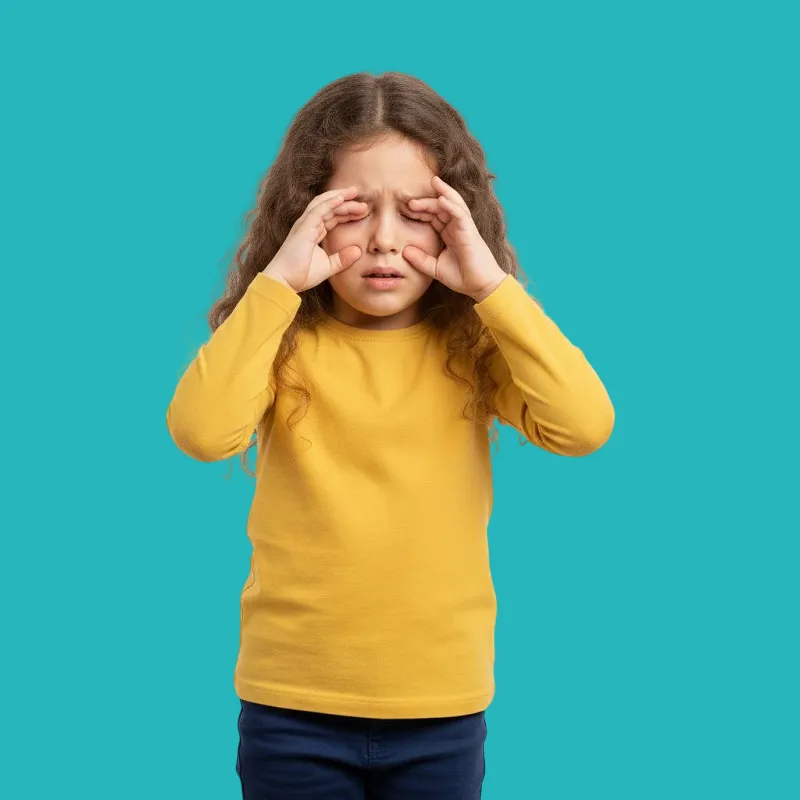Eye allergies in children are among the most common problems that cause redness, itching, and irritation in the eyes.
Treatment for eye allergies aims to reduce inflammation and redness and protect the eyes from allergy complications.
What are eye allergies in children?
Eye allergies in children occur as a result of the immune system's reaction to irritants that affect the eye, including:
- Redness and increased tearing.
- Intense itching that causes discomfort for the child.
- Mild swelling of the eyelids.
- A burning sensation or a feeling of having a foreign object in the eye.
Causes of eye allergies in children

There are many causes of eye allergies, including various factors such as:
- Dust and accumulated dirt in the home.
- Pollen in the spring and fall.
- Pet dander and fur.
- Smoking, perfumes, and strong odors.
Symptoms of eye allergies in children
Symptoms of eye allergies are clearly visible in the eyes, including:
- Persistent redness of the eyes.
- Annoying itching that causes eye rubbing.
- Increased tear production.
- Mild swelling of the eyelids.
Diagnosing Eye Allergies
Diagnosing eye allergies involves a precise medical process, including:
- Examining the eyes to detect redness and swelling.
- Assessing the severity of itching and tearing.
- Recognizing the child's history of exposure to irritants.
- Conducting allergy testing if necessary.
Treating Eye Allergies in Children
Treating eye allergies in children aims to alleviate inflammation and itching. This includes:
- Washing the eyes with lukewarm water to reduce irritation.
- Applying cold compresses to soothe redness.
- Using anti-allergy eye drops as prescribed by a doctor.
- Avoiding rubbing the eyes, as this can worsen inflammation.
When to See a Doctor

There are signs that warrant a doctor's visit when experiencing an eye allergy, such as:
- Redness and itching persisting for more than two days.
- Severe swelling of the eyelids.
- Yellow or green discharge.
- Vision impairment or discomfort.
Complications of Neglecting Eye Allergies
Neglecting eye allergies in children can lead to subsequent problems affecting eye health, such as:
- Increased irritation and chronic inflammation.
- Sleep problems due to discomfort.
- Difficulty concentrating while studying.
- Development of bacterial infections in some cases.
Ways to Avoid Eye Allergies in Children
Prevention is important to reduce eye allergy episodes, including:
- Cleaning the house and rooms to remove dust regularly.
- Washing pillows and blankets periodically.
- Ventilating rooms to remove dust and pollen.
- Keeping pets out of the child's room.
Frequently Asked Questions
Are eye allergies chronic in children?
They can be chronic in some children, but they often improve with treatment and prevention.
Is rinsing the eyes with water sufficient to treat eye allergies in children?
It covers part of the treatment, but anti-allergy eye drops are usually needed.
Can eye allergies be prevented in children?
Yes, by cleaning the room and avoiding dust and pollen.
Do eye allergies affect vision?
Yes, eye allergies may cause temporary blurred vision, but they do not lead to permanent vision impairment.
Article Summary
Eye allergies in children are a common condition that causes redness, itching, and irritation. They can be relieved with home remedies and anti-allergy eye drops.
Prevention, such as cleaning the house and staying away from dust and pets, helps reduce symptoms, improve the child's comfort, and protect their eyes from complications.